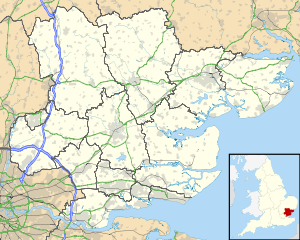Beaumont-cum-Moze
Beaumont-cum-Moze | |
|---|---|
Civil parish | |
 | |
 | |
| Coordinates: 51°52′52″N 1°09′32″E / 51.881°N 1.159°E | |
| Country | United Kingdom |
| Primary council | Tendring |
| County | Essex |
| Region | East of England |
| Status | Parish |
| Population (2011) | |
• Total | 339 |
| Website | Beaumont-cum-Moze Parish Council |
Beaumont-cum-Moze (grid reference TM175250) is a civil parish in the Tendring district of Essex, England. According to the 2001 census it had a population of 352, reducing to 339 at the 2011 Census.[1] The parish includes the hamlets of Beaumont and Moze Cross.
The place-name 'Beaumont' was originally Fulanpettæ in a Saxon charter of circa 995, and Fulepet in the Domesday Book of 1086, meaning 'foul pit'. By 1175-80 it had become Bealmont, meaning 'beautiful hill',[2] a very early example of successful rebranding.
The place-name 'Moze' is first attested in the Domesday Book, where it appears as Mosa. This is from the Old English mos meaning 'marsh' or 'moss'.[3]
Julian Byng, 1st Viscount Byng of Vimy lived at Thorpe Hall in Thorpe-le-Soken and is buried at the 11th-century Parish Church of St Leonard in Beaumont-cum-Moze.[4]
Beaumont Cut is a derelict canal in the parish.
Governance
Beaumont-cum-Moze is part of the electoral ward called Beaumont and Thorpe. The population of this ward at the 2011 Census was 2,300.[5]
Location within Essex |
References
- ^ "Civil Parish population 2011". Retrieved 24 September 2015.
- ^ Eilert Ekwall, The Concise Oxford Dictionary of English Place-names, p.33.
- ^ Eilert Ekwall, op. cit., p.333.
- ^ "The United Benefice of Tendring, Little Bentley and Beaumont-cum-Moze". Archived from the original on 7 July 2013. Retrieved 19 May 2013.
- ^ "Beaumont and Thorpe population 2011". Retrieved 24 September 2015.

